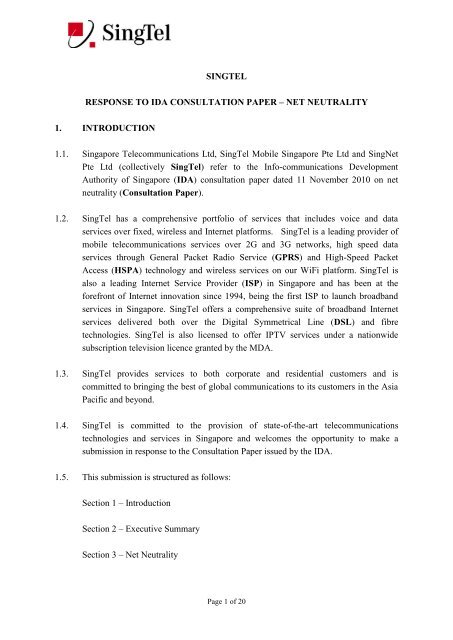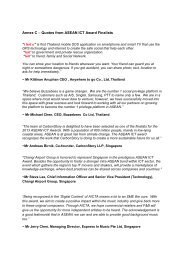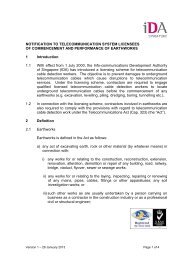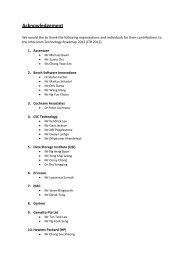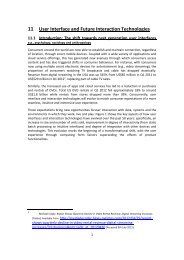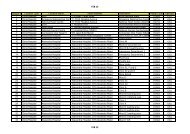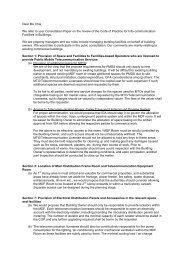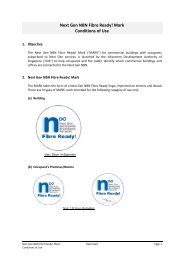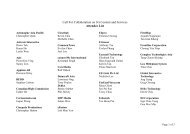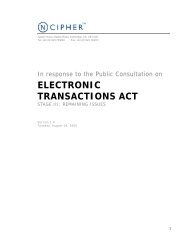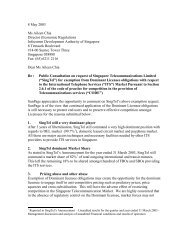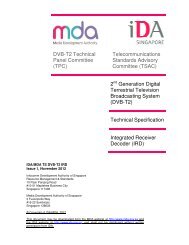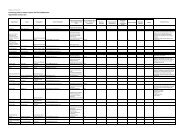SINGTEL RESPONSE TO IDA CONSULTATION PAPER – NET ...
SINGTEL RESPONSE TO IDA CONSULTATION PAPER – NET ...
SINGTEL RESPONSE TO IDA CONSULTATION PAPER – NET ...
Create successful ePaper yourself
Turn your PDF publications into a flip-book with our unique Google optimized e-Paper software.
<strong>SINGTEL</strong><br />
<strong>RESPONSE</strong> <strong>TO</strong> <strong>IDA</strong> <strong>CONSULTATION</strong> <strong>PAPER</strong> <strong>–</strong> <strong>NET</strong> NEUTRALITY<br />
1. INTRODUCTION<br />
1.1. Singapore Telecommunications Ltd, SingTel Mobile Singapore Pte Ltd and SingNet<br />
Pte Ltd (collectively SingTel) refer to the Info-communications Development<br />
Authority of Singapore (<strong>IDA</strong>) consultation paper dated 11 November 2010 on net<br />
neutrality (Consultation Paper).<br />
1.2. SingTel has a comprehensive portfolio of services that includes voice and data<br />
services over fixed, wireless and Internet platforms. SingTel is a leading provider of<br />
mobile telecommunications services over 2G and 3G networks, high speed data<br />
services through General Packet Radio Service (GPRS) and High-Speed Packet<br />
Access (HSPA) technology and wireless services on our WiFi platform. SingTel is<br />
also a leading Internet Service Provider (ISP) in Singapore and has been at the<br />
forefront of Internet innovation since 1994, being the first ISP to launch broadband<br />
services in Singapore. SingTel offers a comprehensive suite of broadband Internet<br />
services delivered both over the Digital Symmetrical Line (DSL) and fibre<br />
technologies. SingTel is also licensed to offer IPTV services under a nationwide<br />
subscription television licence granted by the MDA.<br />
1.3. SingTel provides services to both corporate and residential customers and is<br />
committed to bringing the best of global communications to its customers in the Asia<br />
Pacific and beyond.<br />
1.4. SingTel is committed to the provision of state-of-the-art telecommunications<br />
technologies and services in Singapore and welcomes the opportunity to make a<br />
submission in response to the Consultation Paper issued by the <strong>IDA</strong>.<br />
1.5. This submission is structured as follows:<br />
Section 1 <strong>–</strong> Introduction<br />
Section 2 <strong>–</strong> Executive Summary<br />
Section 3 <strong>–</strong> Net Neutrality<br />
Page 1 of 20
Section 4 <strong>–</strong> Speed Issues<br />
Section 5 - Conclusion<br />
2. EXECUTIVE SUMMARY<br />
2.1. SingTel submits that there are no net neutrality issues in Singapore. In particular,<br />
SingTel notes that the net neutrality debate is distinct from issues relating to Internet<br />
speeds and differentiated Quality of Service (QoS) and prices.<br />
2.2. In respect to net neutrality, SingTel submits that:<br />
- the Singapore Internet market is characterised by strong competition;<br />
- competition leads to the best outcomes for customers;<br />
- any regulation should be evidence-based and proportionate to the identified anticompetitive<br />
conduct;<br />
- network management practices are not anti-competitive, and are in fact essential<br />
tools that allow service providers to:<br />
� manage the efficiency of the network;<br />
� improve latency, jitter and packet loss issues;<br />
� increase or facilitate usable bandwidth and render reasonable QoS; and<br />
� invest and innovate in their networks.<br />
- SingTel does not block legitimate Internet content and blocking of websites is<br />
only carried out upon request by relevant authorities and in compliance with<br />
regulatory requirements; and<br />
- international developments, in particular, regulatory action in the US and Canada<br />
must be viewed in the context of those regulators imposing evidence-based<br />
responses to deal with systematic market failures in those countries. There is no<br />
market failure in Singapore.<br />
Page 2 of 20
2.3. In respect to the issue of Internet speeds, SingTel submits that:<br />
- SingTel complies with minimum broadband QoS standards;<br />
- SingTel complies with prevailing requirements to publish service information and<br />
network management practices; and<br />
- the publication of average or expected speeds is counter-productive and likely to<br />
confuse consumers.<br />
3. <strong>NET</strong> NEUTRALITY<br />
Summary<br />
3.1. The <strong>IDA</strong> has invited comments on the following:<br />
- the current state of net neutrality developments in the local Internet access market;<br />
- possible developments in net neutrality in the future; and<br />
- <strong>IDA</strong>’s policy approach towards net neutrality.<br />
3.2. In summary, SingTel submits that:<br />
- Singapore is characterised by a highly competitive Internet market and there is no<br />
need for regulatory intervention in this market;<br />
- regulation must be evidence-based and there is no evidence for the need for<br />
regulation in Singapore;<br />
- network management practices are crucial and essential to the efficient<br />
management of the Internet and should not be affected by regulation;<br />
- international developments should be viewed in their context; and<br />
- existing levels of regulation in Singapore are more than sufficient to curb potential<br />
anti-competitive conduct in the net neutrality context.<br />
Page 3 of 20
The concept of net neutrality<br />
3.3. Net neutrality is commonly used to denote a practice where service providers give<br />
preference to traffic originating from certain sites or charge specific web sites for<br />
preferential treatment. However, much of the debate over net neutrality has extended<br />
to cover issues including whether service providers should be permitted to:<br />
(a) charge differently where end-users access different types of content;<br />
(b) take action to deal with traffic that may lead to congestion in their networks;<br />
and<br />
(c) block access to sites or content.<br />
3.4. SingTel is supportive of the spirit of net neutrality.<br />
3.5. However, SingTel submits that there are good reasons for service providers to<br />
implement differentiated pricing, QoS and terms and conditions for usage of their<br />
networks to service end-users with different needs. SingTel submits that there are no<br />
issues arising from differentiated pricing, QoS and terms and conditions for usage and<br />
service providers should be allowed to continue to do so as long as they are<br />
transparent about the terms and conditions with their end-users.<br />
3.6. Similarly, optimising traffic to ensure efficiency in the networks is in fact a good<br />
network management practice implemented by service providers to ensure:<br />
- that the general Internet end-user does not suffer deterioration in service quality;<br />
and<br />
- there is sufficient bandwidth available for sensitive higher quality applications.<br />
3.7. Lastly, SingTel submits that it does not engage in any blocking of access to specific<br />
websites or content except where it is required to do so in compliance with regulatory<br />
requirements.<br />
Singapore Internet service marketplace is highly competitive<br />
3.8. SingTel submits that the strongly competitive Internet service market environment in<br />
Singapore will produce the best outcomes for Singapore consumers.<br />
Page 4 of 20
3.9. There is strong evidence to show that a highly competitive broadband services market<br />
exists in Singapore: End-users have a choice of 69 Internet service providers 1 that<br />
offer differentiated prices plans and QoS delivered over different technologies,<br />
including wireless technologies (whether over the 3G or 2G networks), Digital<br />
Symmetrical Line (DSL), coaxial cable or fibre technologies.<br />
3.10. This means that end-users have the ability to switch Internet service providers if the<br />
service quality they receive from their existing telecommunications provider is not<br />
acceptable.<br />
3.11. In a highly competitive market, any telecommunications provider that degrades enduser<br />
experience to such low levels is at risk of:<br />
- losing customers to other networks; and<br />
- long-term reputational and commercial damage.<br />
3.12. Neelie Kroes, the European Commission Vice President for the Digital Agenda<br />
Telecoms Markets has embraced this view, and stated that broadband competition<br />
could sufficiently remove the need for further net neutrality regulation 2 .<br />
3.13. Kroes has recently stated that 3 :<br />
“Competition at the network level, combined with appropriate transparency<br />
measures, gives customers the ability to choose among different providers for<br />
their internet connections, making any potential danger to net neutrality less<br />
clear and present. After all, if consumers are dissatisfied with the quality of<br />
the internet connection offered by their provider, competition enables them to<br />
switch.<br />
In other words: strong competition in broadband markets may allow a more<br />
relaxed regulatory approach to net neutrality issues. This may allow network<br />
operators and services and content providers to explore innovative business<br />
models, leading to a more efficient use of the networks and creating new<br />
1 Telecoms Licensing System, <strong>IDA</strong>, 9 December 2010.<br />
2 Neelie Kroes European Commission Vice-President for the Digital Agenda Telecoms markets <strong>–</strong><br />
working together for change Brussels, speech delivered on on 23 September 2010.<br />
3 Ibid.<br />
Page 5 of 20
usiness opportunities at different levels of the internet value chain and better<br />
services and applications for European consumers (our emphasis).”<br />
3.14. In the UK, under the revised Framework for Electronic Communications, Ofcom has<br />
powers to intervene to enforce Quality of Service Guidelines 4 . Notwithstanding this,<br />
UK Government Ministers have stated that the use of these powers should not be<br />
necessary if there is an overall adherence to regulatory principles, competition in the<br />
market and the ability to switch between networks 5 . Minister Ed Vaizey has stated<br />
that Ofcom should only intervene if there is anti-competitive conduct in the market<br />
that harms consumers or new innovative companies.<br />
3.15. Similarly, commentators have noted that competition is the best remedy to curtail<br />
discriminatory conduct by operators 6 :<br />
“Net neutrality is difficult to define and enforce, and efforts to do so merely<br />
address the symptom (concern about discrimination) rather than the<br />
underlying cause (lack of competition). Rivalry between access providers<br />
offers the best protection against the erection of new barriers to the flow of<br />
information online (our emphasis).”<br />
3.16. As the <strong>IDA</strong> has already recognised, a competitive environment will reduce the<br />
incentive of telecommunications providers to engage in blocking or discriminatory<br />
conduct that restricts consumer choice in terms of the content, services and<br />
applications they access over the Internet.<br />
Regulation must be evidence-based<br />
3.17. SingTel submits that regulation by the <strong>IDA</strong> should be proportionate and evidencebased.<br />
3.18. Evidence-based regulation requires the regulator to obtain market information relating<br />
to market trends and customer behaviours necessary to make sensible business and<br />
regulatory business decisions and assess the costs and likely success of regulatory<br />
intervention. Key elements of evidence-based regulation include:<br />
4<br />
EC, the revised European Framework on Electronic Communications, see:<br />
http://ec.europa.eu/information_society/policy/ecomm/library/legislation/index_en.htm<br />
5<br />
Harbottle&Lewis, The UK Adopts a Permissive Approach to Net Neutrality, Briefing Note, 19<br />
November 2010.<br />
6<br />
Editorial, The web's new walls How the threats to the internet‟s openness can be averted, 2 September<br />
2010.<br />
Page 6 of 20
- focused policy-relevant micro-economic research (internal and external) on<br />
relevant markets;<br />
- market failure analysis;<br />
- cost-benefit analysis of regulation; and<br />
- regulation impact assessment (a combination of research and cost-benefit analysis<br />
and indicators).<br />
3.19. This is consistent with the Singapore telecommunications regulation and overseas best<br />
practice.<br />
3.20. The telecommunications law in Singapore requires that regulation should be<br />
proportionate and technology-neutral. Article 1.5.4 of the Telecom Competition Code<br />
provides, as follows:<br />
“To the extent that a given market is not yet competitive, significant ex ante<br />
regulatory intervention is likely to remain necessary. Where this is the case,<br />
<strong>IDA</strong> will seek to impose regulatory requirements that are carefully crafted to<br />
achieve clearly articulated results. Such requirements will be no broader than<br />
necessary to achieve <strong>IDA</strong>‟s stated goals.”<br />
3.21. Article 1.5.5 of the Telecom Competition Code states that:<br />
“<strong>IDA</strong>‟s regulatory requirements will reflect the phenomenon of convergence,<br />
which is eroding historic differences among platforms such as wireline, cable,<br />
wireless and satellite. Regulatory requirements will be based on sound<br />
economic principles and, to the extent feasible, will be technology-neutral.”<br />
3.22. Similarly, National Regulatory Authorities (NRAs) in Europe are required to impose<br />
ex ante regulation in a proportionate manner. The European Commission has stated<br />
that 7 :<br />
7 EC Staff Working Document, Explanatory Note, Accompanying Document to the Commission<br />
Recommendation on Relevant Product and Service Markets within the electronic communications<br />
sector susceptible to ex ante regulation in accordance with Directive 2002/21/EC of the European<br />
Parliament and of the Council on a common regulatory framework for electronic communications<br />
networks and services, Brussels 13/11/2007.<br />
Page 7 of 20
“the NRA will need to demonstrate that the obligation in question is based on<br />
the nature of the problem identified, proportionate and justified in the light of<br />
the NRA‟s basic objectives as set out in Article 8 of the Framework Directive”<br />
3.23. Furthermore, EC’s recommendation on electronic communications provides that 8 :<br />
Article 15(1) of Electronic Communications Directive 2002/21/EC requires<br />
the Commission to define markets in accordance with the principles of<br />
competition law. Competition law principles are therefore used in this<br />
Recommendation to set product market boundaries within the electronic<br />
communications sector, while the identification or selection of defined markets<br />
for ex ante regulation depends on those markets having characteristics<br />
which may be such as to justify the imposition of ex ante regulatory<br />
obligations<br />
...<br />
Regulatory obligations must be appropriate and be based on the nature of<br />
the problem identified, proportionate and justified in the light of the<br />
objectives laid down in Directive 2002/21/EC, in particular maximising<br />
benefits for users, ensuring no distortion or restriction of competition,<br />
encouraging efficient investment in infrastructure and promoting innovation,<br />
and encouraging efficient use and management of radio frequencies and<br />
numbering resources (our emphasis).”<br />
3.24. In addition, Neelie Kroes, the European Commission Vice President for the Digital<br />
Agenda Telecoms Markets has recently stated that net neutrality regulation should<br />
remain proportionate. Kroes has stated that 9 :<br />
“... access obligations can only be applied when, following a market analysis,<br />
NRAs conclude that the relevant markets are not competitive and network<br />
operators have significant market power. Access remedies are not<br />
automatically imposed <strong>–</strong> and any remedies imposed must comply with the<br />
principle of proportionality. And this is also why the Recommendation allows<br />
NRAs to fine-tune ex ante remedies to reflect the different level of competition<br />
8 EC Recommendation of 17 December 2007 on relevant product and service markets within the<br />
electronic communications sector susceptible to ex ante regulation in accordance with Directive<br />
2002/21/EC of the European Parliament and of the Council on a common regulatory framework for<br />
electronic communications networks and services<br />
9 Neelie Kroes European Commission Vice-President for the Digital Agenda Telecoms markets <strong>–</strong><br />
working together for change Brussels, speech delivered on on 23 September 2010.<br />
Page 8 of 20
existing in different geographic areas (rural and urban) <strong>–</strong> more intense<br />
competition can imply less intrusive regulation (our emphasis).”<br />
3.25. Further, Ofcom has recently adopted evidence-based regulation in the context of net<br />
neutrality and stated that existing regulatory safeguards should be explored first<br />
before imposing additional Internet regulation.<br />
3.26. Ofcom has stated that 10 :<br />
“our initial position is that discriminatory behaviour is only a potential issue<br />
where firms have substantial „market power‟ and could discriminate in favour<br />
of their own services. In this case, any form of discrimination will come under<br />
very close scrutiny to ensure that there are no anti-competitive effects. We<br />
believe that there is insufficient evidence at present to justify the setting of<br />
blanket restrictions on all forms of traffic management.<br />
The Revised Framework gives NRAs the power to impose a minimum Quality<br />
of Service on communications providers. Our initial view is that in that event<br />
there are a number of approaches we could take but it is likely that our initial<br />
view would be to explore existing competition tools and consumer<br />
transparency options before considering a minimum Quality of Service (our<br />
emphasis).”<br />
3.27. In Australia, the Australian Communications and Media Authority (ACMA) has<br />
adopted a model for evidence based regulation in the context of convergence 11 . First,<br />
the ACMA looks at external drivers for regulation, including:<br />
- changing customer attitudes towards use of communications and service<br />
expectations;<br />
- market and industry diversity and fragmentation of traditional and new media and<br />
communications;<br />
- technology trends; and<br />
- the convergence of boundaries between content creation and distribution channels<br />
and global versus local networks.<br />
10 Ofcom, Traffic Management and Network Neutrality, A Discussion Paper, 24 June 2010.<br />
11 ACMA, ACMA Research: evidence for communications and media regulation, 20-21 May 2008.<br />
Page 9 of 20
3.28. The ACMA then reviews implications for regulation in the context of existing<br />
external drivers, including:<br />
- whether existing regulation meets community standards and attitudes;<br />
- what consumer and audience safeguards are needed;<br />
- whether regulation needs to be adjusted to allow new investment and service<br />
delivery models;<br />
- whether plans and allocation rules needed for new services need to be refined; and<br />
- whether regulatory intervention is in the public interest.<br />
3.29. Following this analysis, the ACMA implements proportionate and evidence-based<br />
regulation.<br />
3.30. As recognised by the <strong>IDA</strong>, the Singapore Internet market is highly competitive.<br />
Further, to date, there has been no evidence of blocking of content or legitimate<br />
Internet content by ISPs or telecom network operators.<br />
3.31. SingTel submits that in the absence of market failures or insufficient competition, it<br />
would be a significant deviation from best-practice in economic regulation to impose<br />
remedies that would restrict operators from engaging in basic network management<br />
practices.<br />
Network management is essential<br />
3.32. SingTel agrees with the <strong>IDA</strong>’s statement that network management techniques can<br />
help balance the use of bandwidth-heavy applications versus the time and quality<br />
sensitive applications on the Internet and maintain reasonable QoS for all end-users.<br />
3.33. SingTel submits that network management techniques are increasingly relevant and<br />
necessary to the management of the Internet. In short, network management<br />
techniques maintain Internet connectivity and enable higher quality-sensitive services.<br />
3.34. Therefore, SingTel submits that the <strong>IDA</strong> must proceed with additional caution when<br />
considering whether to regulate in the field of net neutrality because any such<br />
Page 10 of 20
proposed regulation could have significant and material adverse impacts on current<br />
network management techniques which protect end-users.<br />
Traffic management is necessary to ensure basic service qualities<br />
3.35. Network or bandwidth management practices like traffic shaping or prioritisation are<br />
sound practices to ensure that the general QoS provided to end-users is not<br />
jeopardised as a result of certain end-user behaviours.<br />
3.36. Internet traffic is typically pressed by users of high-data-rate applications such as<br />
online video streaming and peer-to-peer (P2P) file sharing (e.g. bitTorrent<br />
applications). Despite network operators increasing their network capacity,<br />
congestion is an everyday problem that results in downgrading service quality for<br />
end-users.<br />
3.37. As the <strong>IDA</strong> has noted, global IP traffic is expected to significantly increase in the<br />
coming years. Therefore, telecommunications operators are required to employ traffic<br />
management technologies that limit the impact of certain bandwidth-hungry<br />
applications on normal Internet usage while prioritising traffic flows associated with<br />
time-critical applications.<br />
3.38. The NGNBN in Singapore also recognises the importance of prioritisation as a form<br />
of traffic management. NGNBN services are provided by Nucleus Connect using<br />
various Traffic Classes which prioritise traffic based on service or application<br />
demands. Given that the NGNBN serves as a single platform for voice, data and<br />
other forms of traffic, traffic prioritisation represents an essential component of the<br />
provision of services over this platform.<br />
3.39. The need to manage traffic on mobile broadband services is even more critical, as<br />
spectrum is a scarce resource and is typically shared with traditional services such as<br />
voice and messaging. Therefore, mobile broadband is much more likely to suffer<br />
from congestion issues as a result of a handful of users that use the available capacity<br />
for high-bandwidth applications.<br />
Traffic management is necessary to ensure innovation in services and products<br />
3.40. Traffic management is also important in ensuring that differentiated levels of products<br />
and services are available.<br />
Page 11 of 20
3.41. Different services have different quality requirements, such as time, latency, jitter and<br />
packet loss <strong>–</strong> these requirements are well beyond ordinary bandwidth requirements.<br />
Some of the latest applications using the Internet are quality sensitive and require<br />
increased and dedicated bandwidth. An example of such an application is e-Health: e-<br />
Health services rely on high QoS to deliver time, latency and jitter-sensitive traffic.<br />
3.42. Due to the open and un-policed nature of the Internet, there is a real tendency for<br />
high-value and quality applications such as e-Health being crowded out by services<br />
with low economic and social value that are less sensitive to the quality of the<br />
transport mechanism. This results in the potential for significant deterioration in the<br />
network quality and limits the potential for innovation using the high-value, high<br />
quality services.<br />
3.43. While it is possible for network operators to develop vast amounts of reserve capacity<br />
to deal with these congestion issues and assure quality-sensitive traffic is delivered<br />
appropriately, the risk of packet loss is unavoidable.<br />
3.44. Also, the over-provisioning of capacity on networks is a waste of resources and overburdens<br />
networks unnecessarily while subjecting operators to high costs. Network<br />
operators are increasingly unable to justify investment in reserve capacity, especially<br />
when faced with ever-decreasing price levels at the retail level as well as increased<br />
customer demand for higher quality services.<br />
3.45. Accordingly, the only efficient way to address congestion issues is to not address all<br />
incoming traffic with the same priority and assign priority rights to specific services<br />
to be transported immediately at a higher price.<br />
Traffic management does not equal blocking access<br />
3.46. SingTel stresses that network management practices do not result in blocking of<br />
access to sites or content by end-users.<br />
3.47. SingNet does not block P2P traffic. Rather, SingNet has implemented a fair usage<br />
policy that ensures no single traffic protocol monopolizes most of the available<br />
bandwidth at the expense of other traffic protocols, and that end-users using the<br />
Internet for other purposes like web browsing, e-mails and streaming etc. will not be<br />
affected by any surge in P2P traffic in our network.<br />
Page 12 of 20
3.48. The only instance where SingTel blocks access to specific Internet content is to<br />
comply with licensing and regulatory obligations. For example, service providers are<br />
required, under the MDA Internet Code of Practice, to deny access to sites when<br />
notified by the MDA.<br />
3.49. SingNet also publishes information in relation to its network management practices.<br />
International developments in context<br />
3.50. The <strong>IDA</strong> has noted the various international developments, including the netneutrality<br />
debate and the regulatory responses in the US and Canada. SingTel submits<br />
that while international developments are important, they should be viewed in their<br />
context.<br />
3.51. In particular, the regulatory response in the US and Canada to net neutrality issues has<br />
been evidence-based and proportionate to the occurrence of anti-competitive conduct<br />
in that market.<br />
3.52. In the US, the net neutrality debate arose when Comcast Corporation (Comcast), the<br />
largest US cable company and a major broadband service provider, was accused by a<br />
public interest group and several of its customers of blocking customers’ ability to<br />
download video material when they used BitTorrent, an opensource, P2P networking<br />
protocol. In response to the complaints, the FCC opened a formal investigation into<br />
Comcast’s conduct and found its conduct to be arbitrary and discriminatory. The<br />
FCC ordered Comcast to stop its network management practices and develop a<br />
compliance plan. Comcast’s conduct in the US largely stemmed from a lack of<br />
wholesale regulation that made retail services far less competitive than those in<br />
Singapore 12 .<br />
3.53. The debate around net neutrality is ongoing in the US as instances of discriminatory<br />
behaviour continue to occur. Accordingly, the FCC has recently implemented<br />
proportionate regulation to deal with continuing issues of net neutrality in the US. On<br />
21 December 2010, the FCC approved new regulations designed to prevent content<br />
discrimination by Internet service providers 13 . The network neutrality rules will<br />
prohibit providers from impeding the flow of legal and reasonable bandwidth use or<br />
favouring their own content with preferential placement along the information<br />
superhighway.<br />
12 FCC Decision, 1 August 2008.<br />
13 FCC Acts to Preserve Internet Freedom and Openness, 21 December 2010.<br />
Page 13 of 20
3.54. However, the rules have stopped short of preventing Internet providers from creating<br />
tiered speed service or charging customers based on their bandwidth use.<br />
3.55. Similarly, the response by the Canadian regulator, the CRTC, arose from an instance<br />
where one of the leading ISPs blocked access to labour union blogs during a worker<br />
strike, prompting the CRTC to respond with a ban on blocking of websites or content.<br />
3.56. This contrasts with regulatory responses in Hong Kong and the UK where the<br />
regulator has refused to regulate in light of little or no evidence of discriminatory<br />
behaviour by service providers and the existence of strong competition in the market.<br />
3.57. The international director at Ofcom, Alex Blowers has recently stated that “there is<br />
very little evidence that big beasts of the content application and services world are<br />
coming together and doing deals with big beasts of the network and the ISP world 14 ”.<br />
Ofcom’s director has stated that under strong competitive conditions, Internet<br />
subscribers have the ability to switch service providers if and when a service provider<br />
engages in discriminatory behaviours such as the throttling of traffic or blocking of<br />
websites.<br />
3.58. The above examples show that overseas regulators only regulate when there is clear<br />
evidence that market conditions are failing to prevent anti-competitive conduct in the<br />
Internet services context.<br />
3.59. SingTel submits that bespoke net neutrality regulation is not necessary in Singapore.<br />
Existing regulation provides effective deterrent to potential anti-competitive<br />
behaviour in the net-neutrality context<br />
3.60. In summary, for the reasons discussed above, SingTel does not believe that additional<br />
measures are necessary to regulate the Internet service market. The market is highly<br />
competitive and any issues that arise in this market such as net neutrality will be dealt<br />
with through competition.<br />
3.61. Even if the issue does arise, SingTel submits that the level of regulation in Singapore<br />
is sufficient to:<br />
- address potential anti-competitive behaviour; and<br />
14 PC Pro, The End of The Net As We Know It, February 2011.<br />
Page 14 of 20
- promote a competitive Internet services environment.<br />
3.62. As the <strong>IDA</strong> has recognised, there are a number of existing regulatory safeguards that<br />
restrict anti-competitive behaviour and promote consumer interests.<br />
3.63. Section 8 of the Telecom Competition Code prohibits a licensee from engaging in<br />
“unfair methods of competition.” Further, section 3 of the Telecom Competition Code<br />
provides a number of obligations that service providers must observe, including:<br />
(a) duty to comply with <strong>IDA</strong>’s QoS standards;<br />
(b) duty to disclose pries, terms and conditions;<br />
(c) duty to disclose service quality information that is readily accessible to all endusers;<br />
and<br />
(d) complying with mandatory contractual provisions, including on prices, terms and<br />
conditions.<br />
3.64. Also, there are existing safeguards to ensure an open and interconnected<br />
telecommunications network in Singapore. Section 5 of the Telecom Competition<br />
Code requires that all telecommunications licensees must co-operate to promote a<br />
competitive environment.<br />
3.65. These provisions serve to ensure that service providers and operators do not engage in<br />
discriminatory behaviour. SingTel has been, and continues to be fully compliant with<br />
these obligations in respect of its Internet service offerings.<br />
4. DIFFERENTIATED QOS, SPEEDS AND PRICING<br />
Summary<br />
4.1. The <strong>IDA</strong> has invited comments in relation to improving information transparency on:<br />
- the actual or expected Internet access speeds; and<br />
Page 15 of 20
- other issues including potential benefits for consumers, impact on ISPs and the<br />
development of the Internet access market, and the extent of information that<br />
should be made available.<br />
4.2. In summary, SingTel submits that:<br />
- issues relating to the speeds at which Internet services are provided are unrelated<br />
to the net neutrality debate;<br />
- publication of average or expected speeds is likely to be counter-productive and<br />
confuse customers; and<br />
- the information already provided by the <strong>IDA</strong> and SingTel relating to differentiated<br />
services is sufficient to allow customers to make informed choices.<br />
Speed issues are unrelated to net neutrality debate<br />
4.3. SingTel submits that the speed at which Internet services are supplied to end-users is<br />
unrelated to the net neutrality debate <strong>–</strong> that is, the availability of differentiated speeds<br />
and QoS at differentiated prices does not equal non-net-neutral Internet.<br />
4.4. In the current market, it is typical for service providers to differentiate price plans<br />
based on speed and usage levels of end-users. It is not unreasonable, for example, for<br />
service providers to also have different price plans for different speeds and QoS, and<br />
impose tiered charges on wholesale customers.<br />
4.5. Service and QoS differentiation is necessary to ensure the development of new<br />
services, significantly increased levels of demand for bandwidth and maintaining<br />
Internet connectivity for all customers.<br />
4.6. Service and price differentiation provide more choice for end-users. In Singapore, a<br />
plethora of network operators and service providers offer a wide range of<br />
differentiated products and services at different prices. Customers have the power to<br />
choose which content, services and applications they wish to access.<br />
4.7. In a highly competitive marketplace, end-users have the ability to switch providers if<br />
the QoS levels are inappropriate for their needs. Customers with needs for a cheap<br />
low QoS service should not have to bear the burden of paying the same price for high<br />
Page 16 of 20
QoS services. Equally, a customer with high-data-rate needs should be able to switch<br />
providers and obtain a higher bandwidth <strong>–</strong> higher quality service that meets its needs.<br />
4.8. Moreover, ensuring service providers have the freedom to differentiate QoS, prices<br />
and terms and conditions allows them the flexibility and freedom to innovate, both in<br />
terms of product and quality to meet the ever-changing needs of a diverse customer<br />
base.<br />
4.9. Innovation in this respect leads to more customer choice and strengthens competition.<br />
4.10. SingTel notes that there are no critical issues in the Singapore market arising from<br />
differentiated service offerings, or which could arise from the implementation of such<br />
practices. In fact, any regulatory intervention that prevents such practices would:<br />
- disincentivise service providers or carriers from further innovation in their service<br />
delivery;<br />
- reduce the number and choice of available services to customers; and<br />
- ultimately weaken competition.<br />
4.11. Notwithstanding the above, SingTel agrees with the <strong>IDA</strong>’s proposal that where<br />
service providers provide differentiated prices, QoS, terms and conditions, usage<br />
plans or selected restricted Internet websites, they must provide information to endusers<br />
in advance to enable end-users to make informed choices about the service(s)<br />
they intend to take up.<br />
4.12. SingTel submits that the level of information it currently provides to end-users in<br />
terms of the differentiated QoS, price and terms and conditions is sufficient to ensure<br />
end-users can make informed choices.<br />
Notifying end-users of average speeds is counter-productive<br />
4.13. SingTel is concerned about the <strong>IDA</strong>’s proposal to require service providers to publish<br />
average speeds. SingTel believes that publishing average Internet access speeds<br />
under normal surfing conditions or calculating average Internet access speeds<br />
experienced over one (1) month is counter-productive and confuses end-users.<br />
Page 17 of 20
4.14. A representation that an Internet service is likely to achieve an ‘average of’ or ‘up to’<br />
a certain speed may be misleading if the expected speed is a technical speed that has<br />
come about under controlled conditions. This is because a multitude of factors impact<br />
on Internet speeds in the actual uncontrolled Internet environment.<br />
4.15. First, an end-user’s fixed broadband Internet service experience depends not only on<br />
the customer broadband setup, but, also on the application downloaded by the enduser<br />
and the bandwidth and the loading of the overseas servers, which is not within<br />
the control of local service providers.<br />
4.16. Secondly, speeds experienced by end-users are also affected by the means of<br />
connectivity within the premises. For example, in an NGNBN environment, an end<br />
users experience will differ depending on the means of connectivity within the<br />
premise e.g. Cat 5(e)/6 cabling versus Wi-Fi versus powerline networking versus<br />
coaxial-line networking. It is impossible to formulate a single statement which takes<br />
into account the myriad ways in which an end user may connect to the NGNBN<br />
4.17. Thirdly, even when high quality internal wiring is installed at an end user premises,<br />
the average speeds experienced by end-users vary depending on how many people are<br />
using the network at any given time. For example, the average speeds using mobile<br />
broadband Internet can vary based on location or due to the number of end-users<br />
logging onto the same base station.<br />
4.18. Actual Internet speeds are also dependent on other factors, including:<br />
- user mobility, which changes the way traffic is handled;<br />
- the use of different types of smart-phones and/or tablets, which make it difficult<br />
for end-users to appreciate the meaning of average speed in context; and<br />
- the radio signal quality, which can be affected by external interference.<br />
4.19. Even if the speed testing methodology is standardised across the industry, it does not<br />
guarantee end-users that these speeds can be achieved at all locations and at all times<br />
irrespective of the devices and applications they use.<br />
Page 18 of 20
4.20. In considering the issue of publishing average speeds, the ACCC in Australia has<br />
adopted a similar view, and stated that 15 :<br />
“The ACCC considers that maximum, “up to”, or peak network speeds based<br />
on technical specifications can be misleading even when coupled with further<br />
information on the speeds obtainable. A consumer is still likely to understand<br />
the reference to mean that the claimed speed has a reasonable basis and is<br />
achievable, albeit not at all times and in all circumstances.<br />
...<br />
Similarly, the ACCC considers such speed claims to be misleading even if<br />
described as a “theoretical speed”, “hypothetical speed” or “technology<br />
speed”. A consumer is still likely to understand the reference to mean that the<br />
claimed speed has a reasonable basis and is achievable, albeit not at all times<br />
and in all circumstances”<br />
4.21. SingTel submits that the amount of information that is already provided to end-users,<br />
either by the service providers or as published by the <strong>IDA</strong>, is sufficient to allay any<br />
concerns regarding transparency around different speeds and QoS.<br />
4.22. Service providers are already required under the Telecom Competition Code to<br />
publish all the key terms and conditions of their services and price plans. In addition,<br />
the <strong>IDA</strong> publishes a consumer guide on broadband services, which includes the<br />
monthly throughput and latency performance of the main residential broadband plans<br />
as well as the quarterly broadband QoS standards for network availability, latency and<br />
complaints, and the quarterly mobile QoS standards for service coverage, call success<br />
rate and average throughput speeds. End-users are also given information about<br />
factors affecting Internet access speeds and how to improve their broadband<br />
connection.<br />
4.23. SingTel submits that the information currently published by the <strong>IDA</strong> and service<br />
providers provides sufficient transparency on the different variables related to<br />
broadband and mobile services.<br />
4.24. In addition, SingTel notes that business end-users typically enter into agreements with<br />
their service providers that entail specific Service Level Agreements (SLAs) covering<br />
15 ACCC, Mobile and Other Wireless Internet Speed Claims and the Trade Practices Act 1974, An<br />
ACCC Information Paper, September 2009.<br />
Page 19 of 20
QoS and other quality matters. The information relating to expected and average<br />
Internet access speeds will be largely irrelevant to business broadband end-users.<br />
4.25. Therefore, SingTel submits that, if the <strong>IDA</strong> is to require that service providers publish<br />
expected or average Internet speeds, that services available to business end-users<br />
should be exempt from this requirement.<br />
5. CONCLUSION<br />
5.1. In light of the above, SingTel submits that there are no net-neutrality issues in<br />
Singapore.<br />
5.2. Furthermore, SingTel submits that bespoke regulation in the Internet services market<br />
in Singapore is necessary for the following reason:<br />
- the Internet services market is highly competitive in Singapore;<br />
- existing levels of regulation are sufficient to address potential anti-competitive<br />
conduct;<br />
- services providers should be free to manage the efficiency of their networks,<br />
improve customer experience and innovate to facilitate high-quality applications;<br />
- SingTel complies with prevailing to publish service information and network<br />
management practices; and<br />
- SingTel already complies with minimum QoS standards and is transparent in<br />
terms of its network management techniques;<br />
- the publication of average or expected speeds is counter-productive and likely to<br />
confuse consumers.<br />
Page 20 of 20


